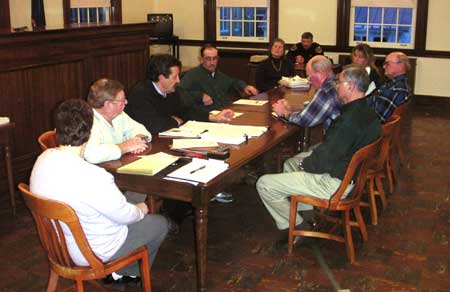BOARD of SUPERVISORS Meeting
20 January 2005
Height regulations sent to planners
The Board of Supervisors met at 5:00 p.m. on 20 January to consider draft height regulations as prepared by Counsel, Melissa Dowd. The draft amendment consists of five short paragraphs, which basically state that a developer who proposes any structure in any zone that will exceed the general height limits must apply for a conditional-use permit and submit to the procedures that that entails. The amendment is entirely generic and lists no upper limit for any structure. Explanatory and editorial comments added to the text of the amendment in italics are mine.
The BOS accepted the draft language of the amendment and sent it on to the Planning Commission for its consideration. They then invited four members of the Industrial Development Authority up to the front table and requested that the IDA undertake a review of industrial wind turbines in the county. Jerry Rexrode, in particular, referred to them as an “industrial” use or facility, seemingly deviating from the more common description as “wind farms” or “windmills.” The IDA will meet to discuss the matter.

|
|
The BOS meets with IDA. Roberta Lambert [back to camera]; Supervisors Jerry Rexrode, Robin Sullenberger, and Lee Blagg; Melissa Dowd [Solicitor]; Herb Lightner [Sheriff]. On right IDA members Richard Shamrock, David Smith, Olin Sponaugle, and Cindy Wood.
|
Roberta Lambert had contacted the State Corporation Commission and learned that, based on current formulas, the revenue to the county would be around $248K/yr, assuming a value of $60M for the facility. The formulas referred to are used for conventional power facilities and could change when the SCC takes up wind facilities specifically, so we are still uncertain about potential revenues. It is not clear to me what the depreciation schedule would be and for how long we could expect to receive the $248K, if at all. It was also revealed that McBride has offered $3K/yr/MW payment in lieu of taxes in the event actual tax revenue falls below that. Such payments would be made for the life of the facility and would be based on MW of installed power capacity. This would amount to $117K/yr assuming an installed capacity of 39 MW.
Roberta then read portions of what appeared to be about a six-page letter from the SCC. An environmental analysis will be required but it was not clear if that means a full Environmental Impact Statement or some lesser level of analysis. This and several other things must be done before the SCC would issue a Certificate of Public Convenience for a facility. At one point Jerry said, “If we turn this down none of that will apply.” What an appealing thought!
Discussion then turned to a number of questions that would be submitted in writing to McBride, mostly from Robin. It was rather hard to hear so I am not sure I caught all of this. Military training flights and the National Radio Astronomy Observatory were discussed. Both were thought to be OK with the McBride project but definitive answers are needed. A major issue with the public being size, Robin asked if smaller turbines would be considered and how that would affect the viability of the project. The study of bat mortality came up and whether there should be a moratorium on construction of new facilities until that is resolved. Senator Warner’s proposed moratorium seems to relate only to off-shore facilities. He has not taken a position on land-based turbines. A more specific site plan was requested, with particular reference to the Goodalls’s home next to Tamarack Ridge. During the field trip last fall no one could say with certainty where the turbines would be or how large they would loom over the Goodall home. View issues in general were discussed. Robin wants to see a computer simulation of the project but seemed unwilling to require a balloon test so the size could be viewed in real life.
Lee Blagg felt that land rights trumped most other considerations, stating that many people he has talked with don’t particularly want to look at these things but feel that a man should be able to do as he likes on his own land. “Where do my rights end and yours begin is key to the whole thing.” Melissa pointed out that we made that decision, at least in part, a number of years ago when a zoning ordinance was adopted. Furthermore, “viewshed” is a much broader concept than just not wanting to look at something. We market our scenery to tourists and if tourism is negatively impacted it will affect the whole county.
Jerry asked about clear cutting and McBride said there would be very few trees cut. Of course his land is already cleared but most other potential sites, such as Jack Mountain, are forested and would be severely impacted by construction. The supervisors seem to feel that they could permit McBride’s project without setting a precedent that would make it hard to deny similar projects on other sites. [That seems wildly unrealistic to me.] Jerry also asked about local purchase of the power, referring to a community in New York that is doing that. I do not get the point of this. Once on the grid all electrons look alike and I do not see why we would want to buy power that is more costly than what we already have anyway.
Finally, the Nature Conservancy and the Valley Conservation Council were mentioned. Apparently neither have taken a stand on wind power but both are monitoring it. The environmental community as a whole is of two minds on the subject, some groups seeing problems and others seeing renewable energy and reduced air pollution and land disruption from mining. Both are right in a sense. Any discussion of wind power needs to be site-specific to be meaningful.
John R. Sweet, Mustoe, VA
Return to the top of this page or go back to the main wind page.
